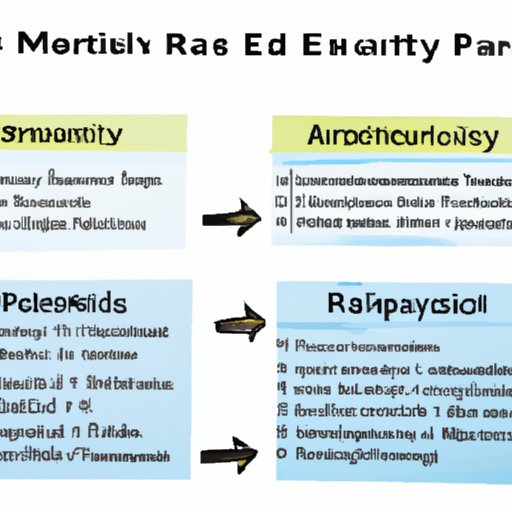Introduction
Exercising regularly is essential for good health and well-being, but it’s important to understand how often you should exercise in order to reap the full benefits. The frequency of your workouts will depend on several factors, such as your current fitness level, the type of exercises you’re doing, and your personal goals. In this guide, we’ll explore all these aspects to help you find the ideal exercise frequency for you.
Developing a Weekly Exercise Plan: What’s the Right Frequency?
The first step in finding the optimal exercise frequency for you is to review your current fitness level. Take into account any physical limitations or injuries you might have, as well as the amount of time you’re able to commit to exercising each week. Once you have an understanding of where you’re at, you can set realistic goals and develop a weekly workout schedule.
When creating your weekly exercise plan, it’s important to consider both the quantity and quality of your workouts. Aim to include a variety of exercises in your routine, such as strength training, cardio, and stretching. This will help you maximize the benefits of exercise while minimizing the risk of injury.
What’s the Optimal Frequency for Reaping the Benefits of Exercise?
Consistency is key when it comes to exercising. Even if you don’t have time for long workouts every day, try to make sure that you’re getting some form of physical activity most days of the week. Research has shown that people who exercise on a regular basis are more likely to see positive results in terms of health and fitness.
Different types of exercises offer different benefits. For example, strength training can help build muscle and improve bone density, while cardio can help increase cardiovascular endurance and burn calories. Stretching and yoga can improve flexibility and balance, while low-impact activities like walking and swimming can help reduce stress and boost energy levels.

How to Balance Rest and Exercise for Optimal Health
It’s also important to understand the importance of rest when it comes to exercising. Too much exercise without enough rest can lead to fatigue, injury, and decreased performance. Make sure to include rest days in your weekly exercise plan to give your body the opportunity to recover and rebuild after each workout.
The key is to find a balance between rest and exercise that works for you. This could mean taking a few days off each week, or simply reducing the intensity of your workouts on certain days. Experiment with different combinations until you find a routine that feels comfortable and sustainable.
The Ideal Exercise Frequency for Maximizing Health Benefits
In general, the ideal exercise frequency for most people is three to five days per week. This allows for enough rest days for recovery, while still providing enough exercise to see meaningful results. However, the exact number of days you should exercise each week will depend on your goals and current fitness level.
Different types of exercises also require different frequencies. Low-intensity activities like walking or swimming can typically be done every day, while high-intensity activities like interval training should be done two to three times per week. It’s important to differentiate between low, moderate, and high-intensity workouts to ensure you’re getting the most out of your exercise routine.
For maximum benefit, combine different types of exercises in your weekly routine. This will help you achieve a balanced workout and prevent boredom from setting in. For example, you could do strength training twice a week and add in some low-intensity activities like swimming or yoga on the other days.

Understanding the Benefits of Different Exercise Frequencies
Low-frequency exercise (1-2 days per week) can be beneficial for those who are just starting out with a fitness routine. This type of exercise can help build a solid foundation of fitness and prepare the body for more intense exercise. However, it’s important to remember that low-frequency exercise won’t yield the same results as more frequent workouts.
Moderate-frequency exercise (3-5 days per week) is generally recommended for most people. This type of exercise offers a good balance between rest and activity, allowing you to reap the full benefits of exercise without overtraining. Moderate-frequency exercise can help you build strength, improve endurance, and lose weight.
High-frequency exercise (6+ days per week) is best suited for experienced exercisers or athletes who are looking to reach peak performance. This type of exercise requires a lot of dedication and discipline, and it’s important to incorporate rest days into your routine to ensure you’re not overtraining.

Finding the Right Exercise Frequency for Your Goals and Needs
When deciding on the right exercise frequency for you, it’s important to consider your individual goals and needs. Ask yourself what you’re hoping to achieve through exercise, and create a plan that takes into account your current fitness level, the types of exercises you’re doing, and the amount of time you’re able to commit to exercising each week.
If you’re new to exercise, start out slowly and gradually increase the intensity of your workouts as you become more comfortable and confident. If you’re an experienced exerciser, challenge yourself by adding in new activities or increasing the duration and intensity of your existing workouts.
Conclusion
Finding the right exercise frequency is essential for achieving your fitness goals and maintaining good health. With the right combination of rest and exercise, you can maximize the benefits of exercise while minimizing the risk of injury. Remember to take into account your individual goals and needs when creating your weekly workout plan, and experiment with different types of exercises to keep your routine interesting and effective.
(Note: Is this article not meeting your expectations? Do you have knowledge or insights to share? Unlock new opportunities and expand your reach by joining our authors team. Click Registration to join us and share your expertise with our readers.)
